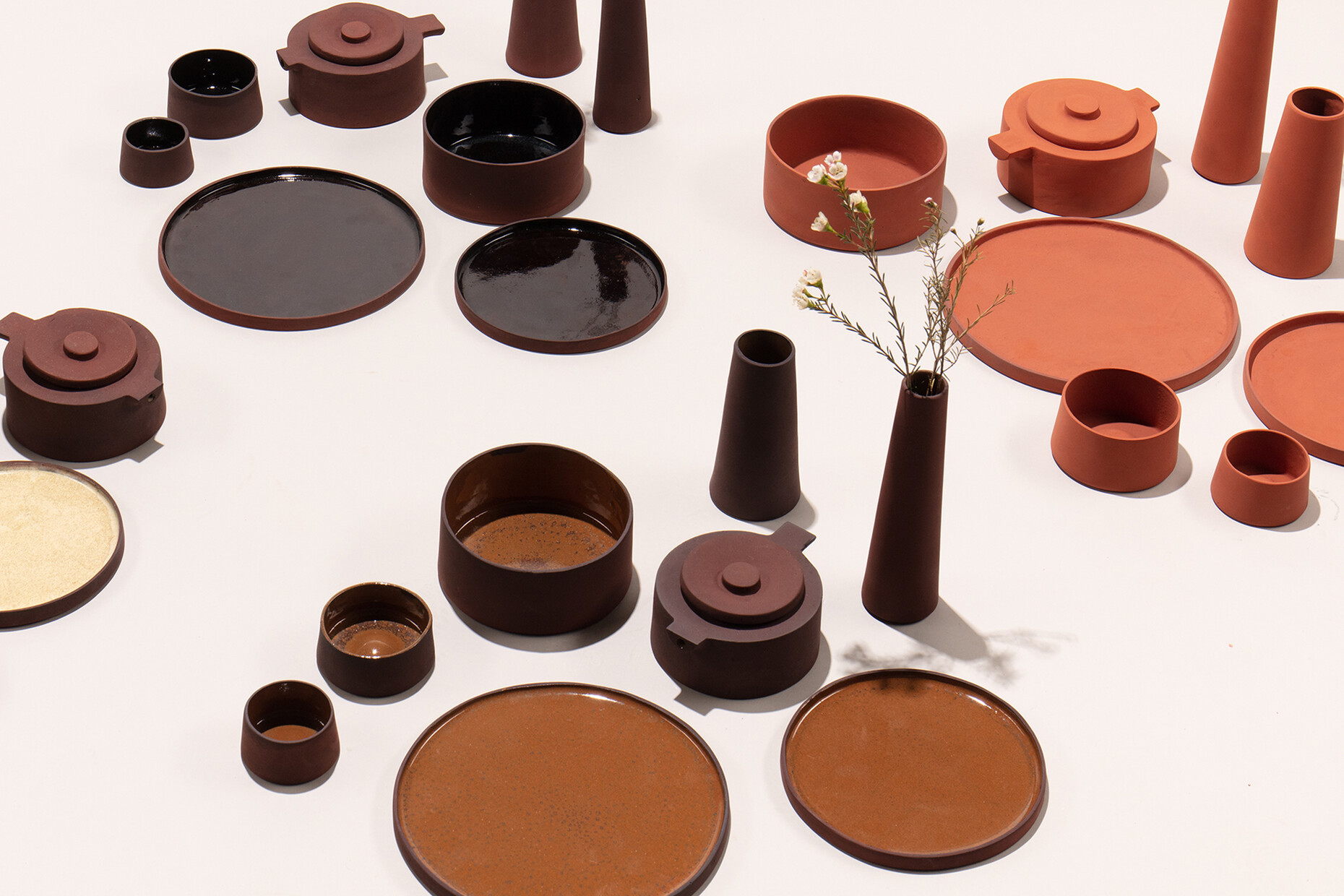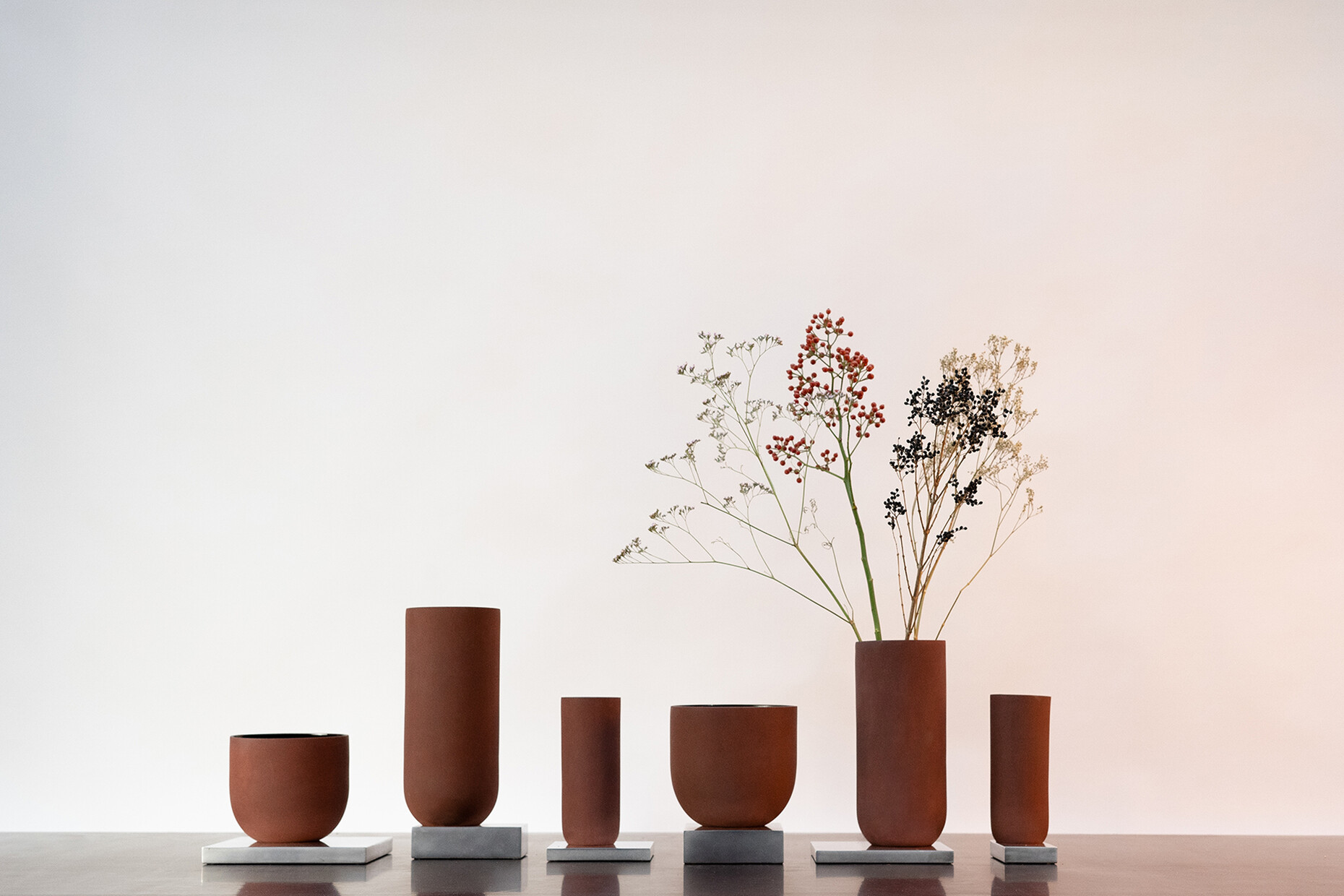SUSTAINABILITY
Change of view
Studio ThusThat are the designers Kevin Rouff, Paco Böckelmann and Guillermo Whittembury, graduates of the Royal College of Art (RCA). In their experimental works, they explore the potential of industrial slags in conjunction with the scientific findings of KU Leuven and other academic institutions. The results of the projects "Red Mud" and "This is Copper" are tableware, vases, lamps and furniture whose colouring, shape and aesthetics are extraordinary. They explain their idea to us in an interview.
Anna Moldenhauer: What fascinates you about industrial waste?
Studio ThusThat: The first project started while we were still at the Royal College of Art (RCA) – red mud, a residual material from alumina production piqued our interest because it is created in large quantities but most of it is not used. The red mud dumps cover so much area that they can even be seen from space. Seeing this extent of production residue shocked us on the one hand, but on the other hand we quickly realised the aesthetics that this material has to offer. Science has been studying the material for decades and has already made many suggestions for its further use as a raw material, of which only a few percent have been taken up by industry.
What do you think is the reason for this?
Studio ThusThat: We don't know that in detail, but generally speaking it boils down to the fact that recycling is not yet profitable for the industry. However, the acceptance of the waste product is just changing, which is also a sign of our times. Public perception is more focused on sustainable production, which encourages research in this area. In addition, the storage costs for red mud have increased. So a shift is in sight, but it is happening very slowly at this point.
For your projects, you work together with international scientists. Was there any insight that particularly surprised you?
Studio ThusThat: The scientists examine the material for its performance, how robust, how acid-resistant is it, what temperatures can it withstand? They follow technical parameters, take material samples to test them, write studies. The aesthetics, the colour of the product is of no particular value to them for the research. The meeting of these different approaches from design and science was therefore very exciting and had many surprising aspects for both sides. Together with them, we created recipes that enable further processing into design products.
Industrial residues such as red mud aka. bauxite residue are toxic to a certain extent, so does your research also include changing their composition?
Studio ThusThat: Yes, composition is a big issue, because before further processing, toxic components such as heavy metals have to be extracted or safely trapped inside the material to prevent leaching. These kinds of waste products are not standardised, at least most of them, which makes further processing difficult. We are trying to promote this standardisation, and though progress is slow there are some exemplary success stories. For example Metallo Group in Belgium, a recycling company for non-ferrous metals, has invested heavily in a process to clean up their slag. And it pays off economically too: In order to make their slag save to use they had to extract heavy metals. One of these elements is zinc. Through their investment Metallo is now able to extract the zinc and sell it at a profit. This effort was not initiated by us, in our project we used the cleaned slag from their plant.
How did the cooperation with the companies whose waste materials you need for your work begin?
Studio ThusThat: After graduating from the RCA, we were invited by KU Leuven to explore their research from a design perspective. Through this project we were able to build up a lot of knowledge as well as contacts in the world of mining and metals. It was interesting to see that the industry is very open to exploring new approaches and understands that as a first step the public perception of these by-products must be changed. Design is an effective means to this. Every metal industry also produces slag and after the research on red mud and copper slag, we are now working on a project with residues from the steel industry.
To what extent does the material determine your product design?
Studio ThusThat: The special nature of the material definitely has a great influence on the design of the products. On the one hand in terms of malleability, aesthetics, but also with the approach of changing the perception of it. So, as a contrast to the brute aesthetic of industrial factories and the vast amounts of red mud, we designed a set of delicate tableware. The design is more of a provocation than a solution. We wanted to bring the materials into people's hands and have them ask questions. Questions that hopefully lead to a change in people's perceptions as well as industrial practices. In addition, there is the desire to create a sustainable alternative to existing building materials such as concrete by recycling the waste products of the metal industry. These alternative cements, called geopolymers, have unique and fascinating characteristics when compared to ordinary cement. Geopolymers from copper slag, for example, can withstand extremely high temperatures as well as thermal shock. This is interesting for certain applications such as tunnel construction. For us as designers/makers these characteristics informed our designs. For example one of the chairs we made is constructed of individual slabs that are then joined together with molten copper.
In other words, it is important to you to create a new awareness of the value of the residual materials from the metal industry, which we call "waste"?
Studio ThusThat: That's it, yes.
Is there any residual material that you would like to investigate?
Studio ThusThat: Besides the quite common Blast furnace slag, there are many other by-products in the steel industry that are little explored. For us, there is a wide field of possible approaches for the near future. However the metallurgical industry is not the only sector that produces fascinating by-products. We have recently started a new project that investigates humanity's relationship with fire through what is left behind: ash. There are countless different types of ash. Most of them can be turned into something useful but more importantly they all tell a story.

















